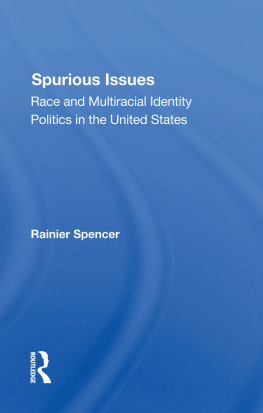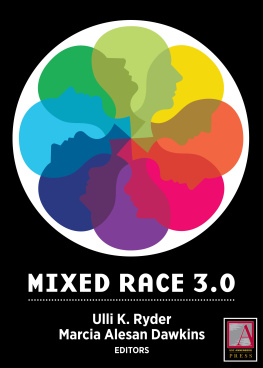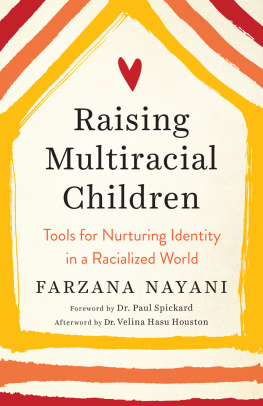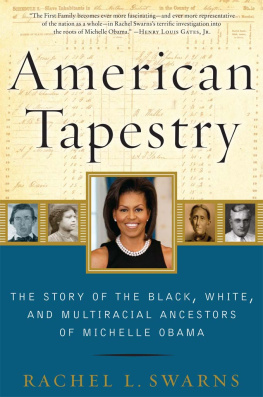The New Face of America
How the Emerging Multiracial, Multiethnic Majority Is Changing the United States
Eric J. Bailey

Copyright 2013 by Eric J. Bailey
All rights reserved. No part of this publication may be reproduced, stored in a retrieval system, or transmitted, in any form or by any means, electronic, mechanical, photocopying, recording, or otherwise, except for the inclusion of brief quotations in a review, without prior permission in writing from the publisher.
Library of Congress Cataloging-in-Publication Data
Bailey, Eric J., 1958
The new face of America : how the emerging multiracial, multiethnic majority is changing the United States / Eric J. Bailey.
pages cm
Includes bibliographical references and index.
ISBN 9780313385698 (cloth : acid-free paper) ISBN 9780313385704 (ebook)
1. Racially mixed peopleUnited States. 2. Cultural pluralismUnited States. 3. Social changeUnited States. 4. United StatesRace relations. 5. United StatesEthnic relations. 6. United StatesPopulation. 7. United StatesSocial conditions1980 I. Title.
E184.A1B233 2013
305.8'050073dc23 2012048978
ISBN: 9780313385698
EISBN: 9780313385704
17 16 15 14 13 1 2 3 4 5
This book is also available on the World Wide Web as an eBook.
Visit www.abc-clio.com for details.
Praeger
An Imprint of ABC-CLIO, LLC
ABC-CLIO, LLC
130 Cremona Drive, P.O. Box 1911
Santa Barbara, California 93116-1911
This book is printed on acid-free paper 
Manufactured in the United States of America
Although I have admired and respected all of my older brothers, this book is dedicated to two of my four older brothersRonnie Bailey and Dwight Eugene Bailey. In my early years growing up in Springfield, Ohio, I tended to be protected and looked after by my brother Ronnie, eight years my elder. He was always around to lend a helping hand. Although we parted ways during my elementary, middle school, high school, and college years, weve maintained our closeness. We are even closer since the passing of his always-caring wife, Debbie.
My brother Dwight is four years older than me and has always been my best friend. Growing up in Springfield and Wilberforce, Ohio, I could always count on him to help me with things important at each stage of my early childhood and young adulthood. He gave me confidence, reassurance, and motivation to be the best that I could be at anything that I wanted to try.
I admire Dwight for being the charismatic, fun-loving, and talkative person whom he has always been.
I especially admire Dwight for taking a stance during the mid-1970s to enter into an interracial relationship when a lot of people did not think it was the right thing to do. I knew that he had made the right decision to marry his wife, Angela. I still (literally) look up to and admire him.
Contents
PART I.
OVERVIEW AND CURRENT ISSUES
PART II.
BACKGROUND ISSUES
PART III.
SIGNIFICANT BIOLOGICAL, HEALTH, AND LIFESTYLE ISSUES
PART IV.
FUTURE TRENDS
Preface
The New Face of America: How the Emerging Multiracial, Multiethnic Majority Is Changing the United States examines some of the most significant issues associated with multiracials today. Despite their increasedand still increasingnumbers across recent decades, there seems to be a total lack of recognition of this group, and of its importance in our society.
In my journey to better understand their issues, I first reflected upon my own personal history. I was exposed to some of these issues throughout my adolescent and early adult years. As an African American raised in the Midwestern state of Ohio during the 1960s and 1970s, my mother always expressed her multiracial, multiethnic heritage. My brothers and I were taught that all of us had relatives of mixed heritage (Native American, French, Creole, and European) and that this mix contributed to the wide diversity of our physical features.
Although this multiracial heritage was brought to my attention in my childhood years, it was not until one of my older brothers decided to have an interracial relationship and marriage that some of these real-life multiracial issues hit home. I admired how my older brother, his wife, and their kids adapted to a world that was, and still is, struggling to embrace them both individually and collectively as a family.
In the past, if individuals or families were biracial/multiracial and had some type of African American heritage (the so-called one-drop rule), their issues were assumed to be primarily African American ones. Today, many biracial and multiracial individuals and families do not adhere to this one-drop rule. I have always felt that the one-drop rule was wrong, discriminatory, and racist. It especially goes against the common right of equality associated with all groups. This is one of many issues addressed in this book.
presents the premise of the book and highlights the significance of the growing multiracial populations in the United States. This opening chapter proposes that the major causes of these groups growth involve an increase in interracial relations and the new cultural trend of openly acknowledging ones multiracial heritage. The chapter concludes with a personal account from one of my key multiracial informants, as I will call them.
examines and compares the 2000 and 2010 U.S. census data. These census data firmly established the existence and growth of multiracial populations in the United States.
investigates how multiracials sometimes struggle with their identity and the major factors influencing their self-identity. Different types of multiracial families are highlighted.
examines the cultural history of multiracialism in America. This chapter highlights specifically the issues connected with those persons who were socially identified as mulattos, mixed bloods, mestizos, Amerasians, and hapas.
reviews the one-drop rule and its historical effect on African Americans. This chapter also examines this concepts cultural impact on multiracials and explains how many multiracials have rejected it.
discusses the topic of race and examines the preferred physical features among racial and ethnic populations in the United States. This chapter contends that multiracial physical features have dramatically influenced the preference for certain types of physical features among other racial and ethnic populations.
highlights some of the major health disparity issues associated with multiracials and discusses the interrelationship of race, ancestry, and genetics with health outcomes. Multiracials views on race-based therapies are also presented.
addresses the challenges that many multiracials experience when they require bone marrow transplants. Because there are so few bone marrow donors who can match the specific blood type of certain multiracials, an exact bone marrow match is difficult to find.
addresses the issue of transracial adoption both from the parents perspective and from the child/adults perspective. A new model with a cultural approach for understanding and solving transracial adoption issues is presented.
recognizes the accomplishments of a number of multiracial celebrities who have had a direct impact in the movie industry, sports, television news journalism, and politics. This chapter also highlights the charitable causes and organizations that have benefited, and further spread the fruits of success, from these celebrities.
examines how multiracials have been treated around the globe, paying special attention to their roles in Europe, Africa, Asia, and South and Central America.







